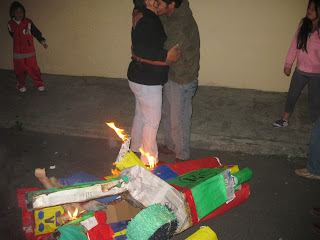Month #1 of Year #2011.
Here are the best parts:
1. On the same night that I traveled to Quito to meet up with Rosada (from here on out to be refered to only as SuperRo, down for six weeks from California), Anne (fellow Fulbrighter) rented a chiva as the mobile venue for her January 6th birthday celebration. [It should be noted that January 6th is also the day that one of my most favorite humans opened her sparkling yellow eyes to the world for the first time...at least I think they're yellow.] For those who don't happen to reside in Ecuador, a chiva is a party bus. I've ridden - and partied - on things that called themselves "party buses," but all those vehicles paled in comparison to the Quito chiva. Anne, in her brilliance, suggested that we, as representatives of our country on "cultural exchange," had a responsibility to experience the culturally unique phenomenon of the chiva. In brief: It has no seats, windows, or rules. (Except for maybe the rule that prohibits climbing onto the roof, as tested by SuperRo.) It plays it's music way too loud, but it plays lots of Shakira. Its operators stock it with Igloo coolers full of canelazo. Its fog machine periodically spits clouds thick enough to choke an passenger caught off guard. The chiva, as a participant in our cultural exchange, may well have taken more than offered.
2. SuperRo and I took a much-needed Sunday trip to the highlands. We caught the early bus to Quilotoa and walked around the rim of the crater (a four-hour event), closing our day spent above 12,000' with pizza (of course).
 |
| With Ro at Quilotoa. |
3. I canceled my classes on the Wednesday of that next week so that SuperRo and I could head east without the stress of hurried travel. We spent Wednesday in Banos. After weeks of bitter cold and consistent rain in the high Sierra, the sunshine and sticky heat in Banos was a welcome surprise. We walked up, up, up until we achieved a spectacular panoramic view of the town, the Pastaza River, and Tunguruahua Volcano. We drank homebrewed amber beers on the roof of our hotel and went soaking with the one-third of the country's population that night. The next morning (after eating huevos rancheros and drinking real coffee!) we went to Tena.
4. In Tena, Matt Terry (of the
Ecuadorian Rivers Institute) took me to visit a school in one of the nearby eastern Kichwa communities. The primary objective of this trip to Tena was to meet with this school's administration to invite their participation in an arts-based technology project for which I have, in collaboration with Maria, a Quito-based Fulbrighter, been trying to garner interest and support. By the time we arrived, the
rectora had left for the evening. We made an appointment for the following morning. We spent the rest of that afternoon with Matt and his lovely ladyfriend, Andalucia, eating, talking, and hunting down boats to use for the weekend.
The following morning, Matt and I ventured out once again to the school. The rectora's interest was limited. My spirits plummeted. Matt, as always, had solutions that I have yet to explore and insight that only someone intimately acquainted with the workings of Ecuadorian institutions can offer. After a short debriefing and discussion, we went kayaking.
The Rio Inchillagui is a class III creek. It's small, fast, and technical with no real consequences for poor paddling. Matt and Andalucia took a double ducky (which was at once hilarious and impressive; their tandem ducky skills are phenomenal) and SuperRo and I kayaked. The Inchillagui flows out of the mountains and is filled with crystal-clear and shockingly warm water. It eventually meets up with the Misahualli and gets bigger, colder, and dirtier. It flows in between way too many unsightly gravel mines, ineffectual flood retaining walls, and rapidly eroding banks. Floating this section with Matt was a little painful. His knowledge of the destructive and seemingly thoughtless projects/developments in the Napo province is overwhelming and discouraging. I will post photos of these projects when I can. For now I only have the following videos:
Rain on the Inchillagui:
Construction of "the wall" on the Misahualli:
Ro and I were convinced (tempted by the offer of free lunch) to work as "safety boaters" for a raft trip (with an indigenous-owned company whose name we are still unsure of) on the Jatunyacu the next day. We accompanied four boats and one fledgling 14 year-old kayaker (adorable Alvaro) on a mess of trip whose mishaps were only funny because the water was low and the wads were strong. For our part, Ro and I did little to earn the laughable title of safety boaters. Mostly we just ate the free lunch.
The next day we decided to kick it up a notch and headed with our friend Diego to the upper Misahualli. We were warned that it was lacking one important element: water. We decided to try it anyway. This run would probably be fun with, as we decided, 50 to 100 more cfs. It was, in the state we saw it, punishing, at least for this girl. I will post photos when I can steal them from SuperRo.
5. My solo return to Latacunga was followed by busy days and nights. The university is celebrating its anniversary and last week's schedule was strangely altered as a result. Next week, too, student attendance will be "unpredictable," but the presentations, programs, and forums that have been organized in honor of the anniversary have been well-attended by students and staff alike. I look forward to reporting (when I have more energy and available insight) on my perceptions of the Primer encuentro nacional al rescate de las lenguas ancenstrales (1st Annual National Gathering for the Rescue of Ancestral Languages). The discussion of this event, my friends, warrants preparation in the form of a full night's sleep...























